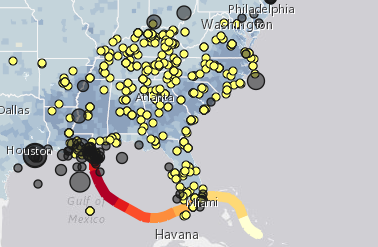The Southeast Region includes Alabama, Arkansas, Florida, Georgia, Kentucky, Louisiana, Mississippi, North Carolina, South Carolina, Tennessee, and Virginia.
|
At a glance: sea level rise, oil spills, tropical diseases, invasive species
The landscapes of the Southeast are incredibly diverse, ranging from the Appalachian Mountains averaging over 3,000 ft in elevation to the beaches and coastlines that sustain fisheries, tourism, and energy extraction activities. The region is home to 80 million people and growing rapidly. However, many coastal cities and their transportation systems are frequently at or below sea level (such as New Orleans), placing their economic networks in danger of rising sea levels and increasing severe storm activity that all result from a changing climate. These climate risks are already playing out in insurance markets, where obtaining coverage for housing in vulnerable areas may differentially impact people based on socioeconomic status. The production and transportation of energy (oil, natural gas, and coal) is central to the Southeastern economy. Stretching from Corpus Christi, TX to New Orleans, LA, the region in the Gulf Coast is home to half of all the offshore refineries in the U.S. which provide 90% of the nation’s offshore energy production and 30% of its total oil and gas supply. Pollutants and contaminants produced by energy industries can damage the sensitive marine environments that provide tourism and fisheries jobs. The most prominent case in recent years is the BP/Deepwater Horizon oil spill disaster in 2010, which severely crippled local fisheries and ecosystems. Studies have shown that industrial pollutants increase the risk of reproductive and developmental problems, cancer, and various other health problems. The local climate, geography, and transportation networks provide an ideal opportunity for the spread of invasive species and diseases. Some of the better-known invasives are the Lionfish in the Atlantic Ocean and the Burmese Python in the Florida Everglades. As temperatures warm, exotic mosquitoes are moving northward from the Caribbean and Central America, with cases of tropical diseases such as dengue and chikungunya on the rise. Travelers have returned from abroad affected by chikungunya to all but two states (as of 2015), although Florida is the only state so far where people have caught chikungunya from mosquitoes inside the US. |
Your browser does not support viewing this document. Click here to download the document.
The Southeast Regional Team:
Isabel Cardenas, Amy King, Lauren Nguyen, Hong Bo Ye For more information on this region: 2014 National Climate Assessment - Southeast USDA Regional Climate Hub - Southeast Hub | ||||||||||||

